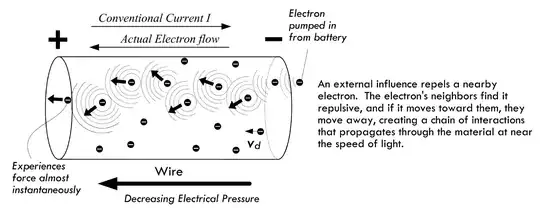I'm reading a book called Practical Electronics for Inventors and it describes the method by which batteries generate electron flow as follows: the battery releases a few electrons via a chemical reaction; the free electrons floating in the wire adjacent to the anode are repelled by these additional electrons, so they shove the free electrons adjacent to them and this process continues all the way to end of the wire near the cathode.
The book then says
"It is likely that those electrons farther “down in” the circuit will not feel the same level of repulsive force, since there may be quite a bit of material in the way which absorbs some of the repulsive energy flow emanating from the negative terminal (absorbing via electron-electron collisions, free electron–bond electron interactions, etc.)."
The book is essentially describing voltage as the relative capacity to "shove" adjacent electrons and it says the electrons near the cathode feel the least "shove" because throughout the circuit electrons have been colliding with other things.
I understand how this explains resistance when an actual load is placed in a circuit (LED, resistor, etc). But what if you connected the ends of a battery with a wire? Will the free electrons in the wire near the cathode feel the least "shove" because the "shoving force" diminishes due to electrons colliding with the wire walls? Or is this effect marginal in wires, so free electrons near the cathode are equally capable of shoving as the ones near the anode? The reason this confuses me is because one can obviously connect a multimeter across a battery to measure its voltage, but doesn't that imply there's a difference in shove between electrons at the ends despite the lack of a load?
